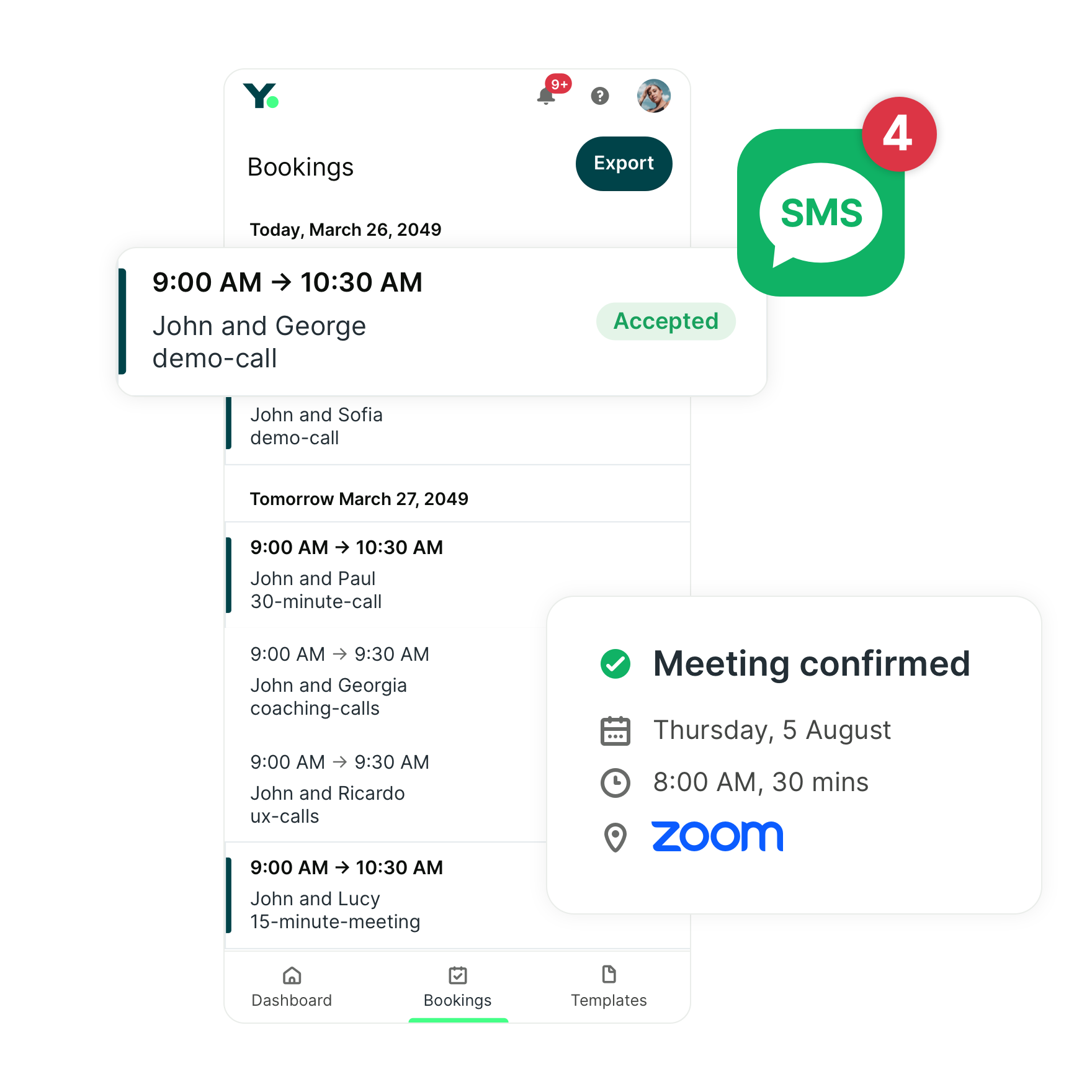How to Create An Effective Client Meeting Agenda
Show up prepared for your next client meeting with these meeting agenda templates and tips.

Hailey Hudson

Ready to book more meetings?
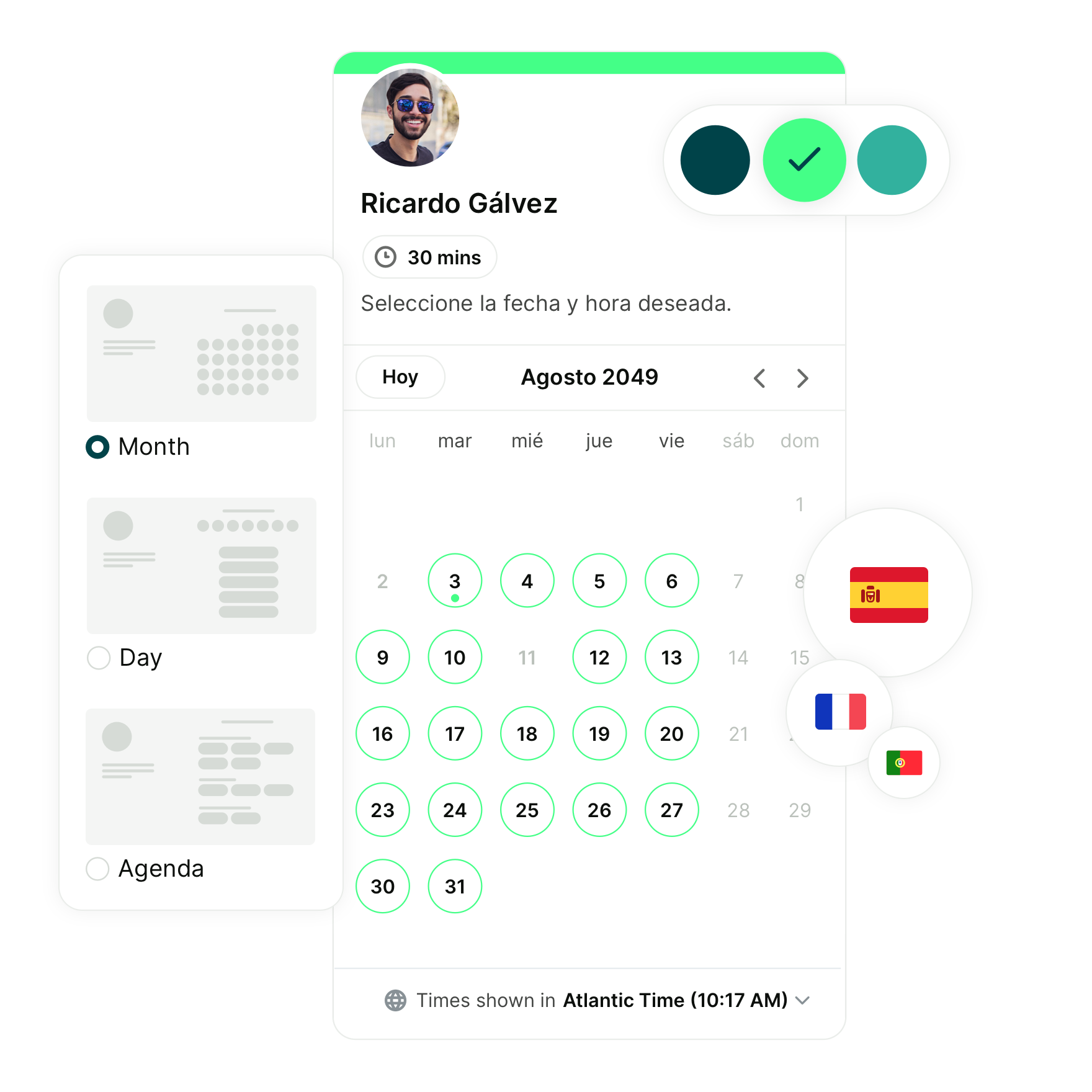
Contents
Have you ever had an awkward first date? The other person showed up late, the conversation felt forced, and when you ducked into the bathroom for a moment of peace you noticed a piece of food in your teeth.
Maybe you’ve been on other dates where you rehearsed what to say on the way to the restaurant. You came up with a mental list of topics in case the conversation lagged. Chances are, you walked into that date feeling more prepared and confident, and the evening flowed smoothly.
Client meetings are a different situation than dates. But there’s one area where these two overlap, and that’s preparation.
A client meeting agenda can make all the difference in the success of your meeting—and ongoing relationship. In this article, you’ll learn how a strong meeting agenda will help your meeting achieve its objective. Plus, get started writing a good agenda with our free client meeting agenda templates.
Let’s dive in!
What’s the purpose of a client meeting agenda?
When you walk into a meeting with an agenda in hand, you’ll be prepared to:
- Make the best use of everyone’s time
- Run an organized meeting with a clear structure
- Come across as professional, capable, and prepared
Taking the time to write a client meeting agenda might feel like it’s cramping your style. But the benefits of an effective meeting agenda—with clear meeting objectives—make this upfront investment 100% worth it.
What should you include in a client meeting agenda?
Your meeting agenda has one big goal: making sure everybody is on the same page. By sharing an agenda prior to the meeting, you’ll help ensure that all meeting attendees are aligned about the meeting’s purpose, details, and goals. It also ensures that everyone can show up prepared.
This means your agenda should include everything attendees need to know about what’s going to happen at the meeting (without getting too wordy—think of your agenda as a preview of the meeting).
Take a look at the anatomy of an effective meeting agenda:
- Time and place: These details might seem obvious, but don’t leave them out! People can’t participate in the meeting unless they’re clear on when and where it’s happening. (For virtual meetings, make sure to include any necessary Zoom passcodes or other information.)
- Goal: The objective of your meeting might be to plan next month’s content calendar, kick off a big project, or simply check in to ensure alignment for the upcoming week. Whatever the case, include a concise description of what the meeting should accomplish on your agenda.
- Attendees: List which team members need to be present at the meeting. If you aren’t sure who needs to attend, refer back to your meeting goals. Think about which people, teams, or departments will have a hand in accomplishing those goals.
- Agenda items: Create a list of topics you’ll want to address during the meeting. These might be specific questions that need to be answered (“What goals did you accomplish last week?”), or broader topics for conversation (“Review of investment opportunities”).
-
Talking points: Within your agenda items, be sure to add helpful context and key points to ensure the conversation stays focused and on track when you meet.
-
- Responsibilities assigned: Whether you've met before or this is your first meeting, it's likely that you've assigned "pre-work" for attendees. Be sure to call that out in the meeting agenda so everyone shows up prepared.
- Duration: What’s the length of the meeting? It’s important to set expectations around how much time people are agreeing to commit to your meeting.
In some cases, you may also want to attach relevant resources or documents to the agenda.
💡 Pro tip: If you have standardized meetings, like intro sessions or monthly check-ins, create a meeting agenda template for each meeting type. That way, you'll never have to start from scratch.
Agenda items and prioritization
It can feel easy to want to talk about anything and everything when meeting with a client. In some cases, it's because you're simply excited to meet with them. In others, you may feel pressured to want to show your value and lay it all out on the table. Putting a meeting agenda together before meeting is a great way to gut-check the discussion you're planning to have.
Agenda items should be carefully selected and prioritized to ensure that the meeting:
- Is focused on achieving your meeting objectives
- Covers the most important things first (especially in cases where you run out of time)
As the meeting organizer, you should work with team members and your clients to identify the key issues to be discussed and allocate sufficient time for each agenda item.
Sometimes, your meeting agenda can be simple
One thing to note is that sometimes you don't need to go all-out on a meeting agenda. Maybe you've already had extensive conversations and the client meeting is strictly a meet-and-greet.
At this point, don't feel like you need to force an agenda. Instead, you can include something simple in your calendar invite to ensure everyone's on the same page going into the call. Take a look at this simple meeting agenda example:

How agendas create effective client meetings, from start to finish
A strong agenda is your roadmap to running a productive meeting that covers every base with none of the fluff. Here’s how an agenda creates more productive meetings—before, during, and after.
Before
Empower your client to be prepared:
A good meeting agenda equips everybody to show up prepared with the information they need. Not everyone likes being put on the spot. Sharing the meeting agenda in advance gives people time to think. When they know what’s going to happen at the meeting, they’ll show up feeling more prepared to discuss.
Depending on your situation, a shared online agenda may be more beneficial than sending a pdf. That way your client can add in their thoughts before you meet.
Empower yourself to be prepared:
This is true for you, too. When a client adds their own items to the agenda, it gives you time to prepare for the meeting too. Depending on your business, having your agenda in place will also help you determine if senior leadership should be involved in the call or not.
Foster a collaborative environment:
What’s more, an agenda creates a collaborative environment. All attendees can (and should!) add items to the agenda. This is beneficial because it improves overall creativity and gives everyone a voice.
Best practices pre-meeting:
- Make it easy for your client to book a meeting with you using a platform like YouCanBookMe. Avoid the tedious back-and-forth emails and give your clients access to your calendar so they can pick the most convenient time for them.
- Send out your meeting agenda at least 1-2 business days before the meeting.
- Send out a meeting reminder email 1-2 days before the meeting and the morning of.
- Include your cancellation policy in your meeting reminder email.
To reduce the administrative work on your end, use an online scheduling tool to set up automations around confirmation emails, meeting reminders, etc.
During
A meeting agenda is helpful during the meeting because it keeps everybody on track and ensures productive conversations.
Think of your agenda items as guardrails, making sure the conversation doesn’t veer into unproductive territory.
Make sure you take notes during each client meeting. If you run out of time, you can refer back to the notes when you’re prepping your next meeting agenda to remember where you left off and where to start. You can also send a copy of the meeting notes to your client, freeing them up to simply be present during the meeting itself.
After
As your meeting wraps up, consider whether you’ve achieved the meeting goals and what needs to happen next. Document a list of next steps to distribute in a follow-up email. Then assign tasks where necessary. Meeting attendees can hold each other accountable to complete each task.
Having next steps and meeting notes documented will also set you up for success to prepare agendas for future meetings too.
Here's a follow-up email template for financial coaches:
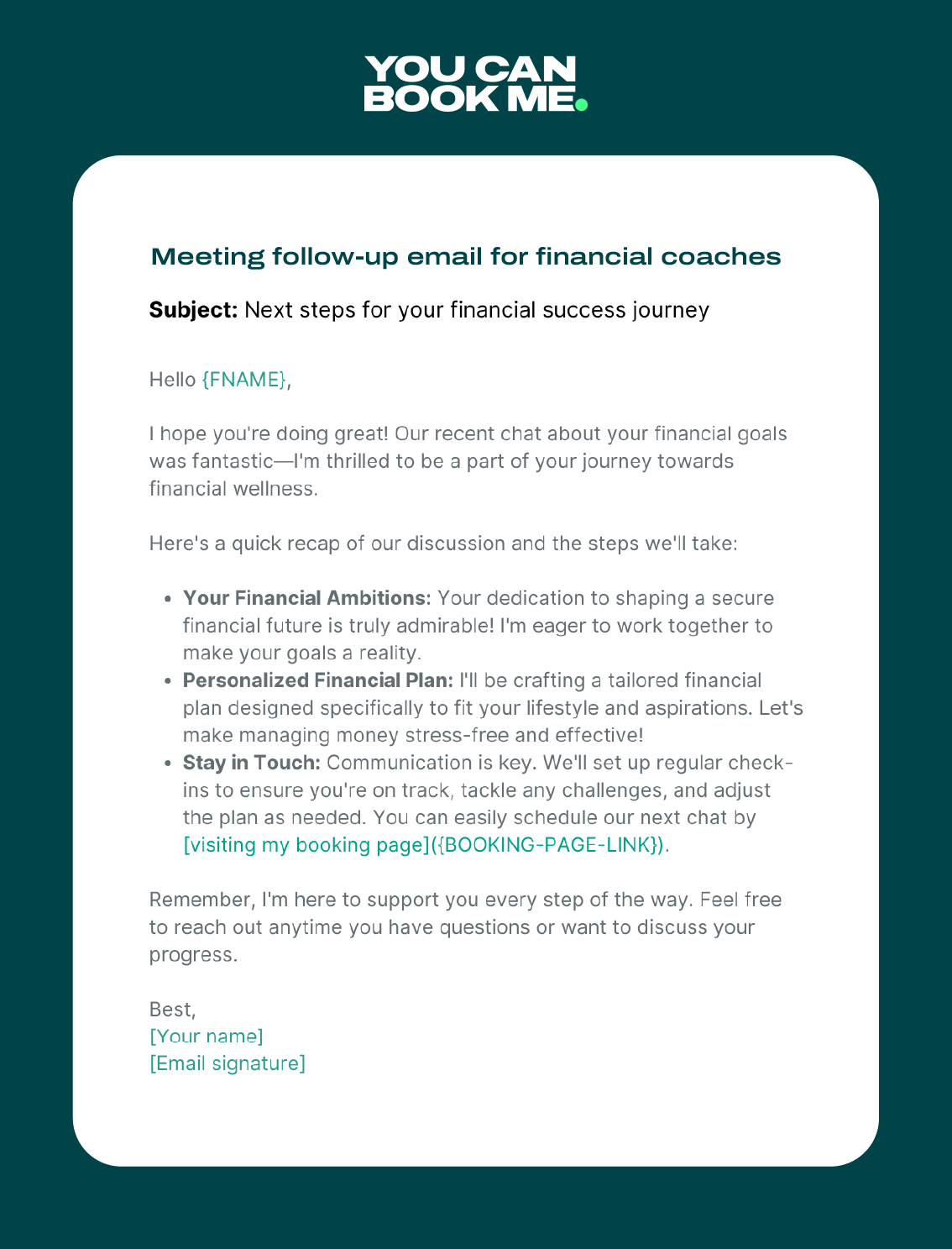
Client meeting agenda template examples
Once your meeting is on the calendar, make sure you’re prepared with an effective meeting agenda that includes everything listed above—the meeting details (including location and attendees), meeting goal, and a list of topics to discuss.
There's no need to reinvent the wheel—especially for recurring meetings, like a weekly check-in, one-on-one meeting, or monthly planning meeting. Instead, rinse and repeat by using meeting agenda templates.
In many cases you’ll have standing agenda items (things that repeat each week) and one-off items. Just plug in the details that change, like the list of topics to discuss.
New client meeting agenda template
Meeting with a new client for the first time? Make a good impression by coming prepared with a meeting agenda. Here’s an example template to use.
Zoom meeting, 2:00 PM EST, Friday, January 19th
Attendees: Jane Doe and Susan Smith
The goal of this meeting is to get to know each other, discuss our process, and understand what your primary goals are moving forward.
Agenda items:
- Introductions: Get to know each other better
- What are you hoping to accomplish during our time together?
- How do you measure success?
- What do you need the most help with right now?
- Plan out how we’ll work together in the next coming months
- Next steps
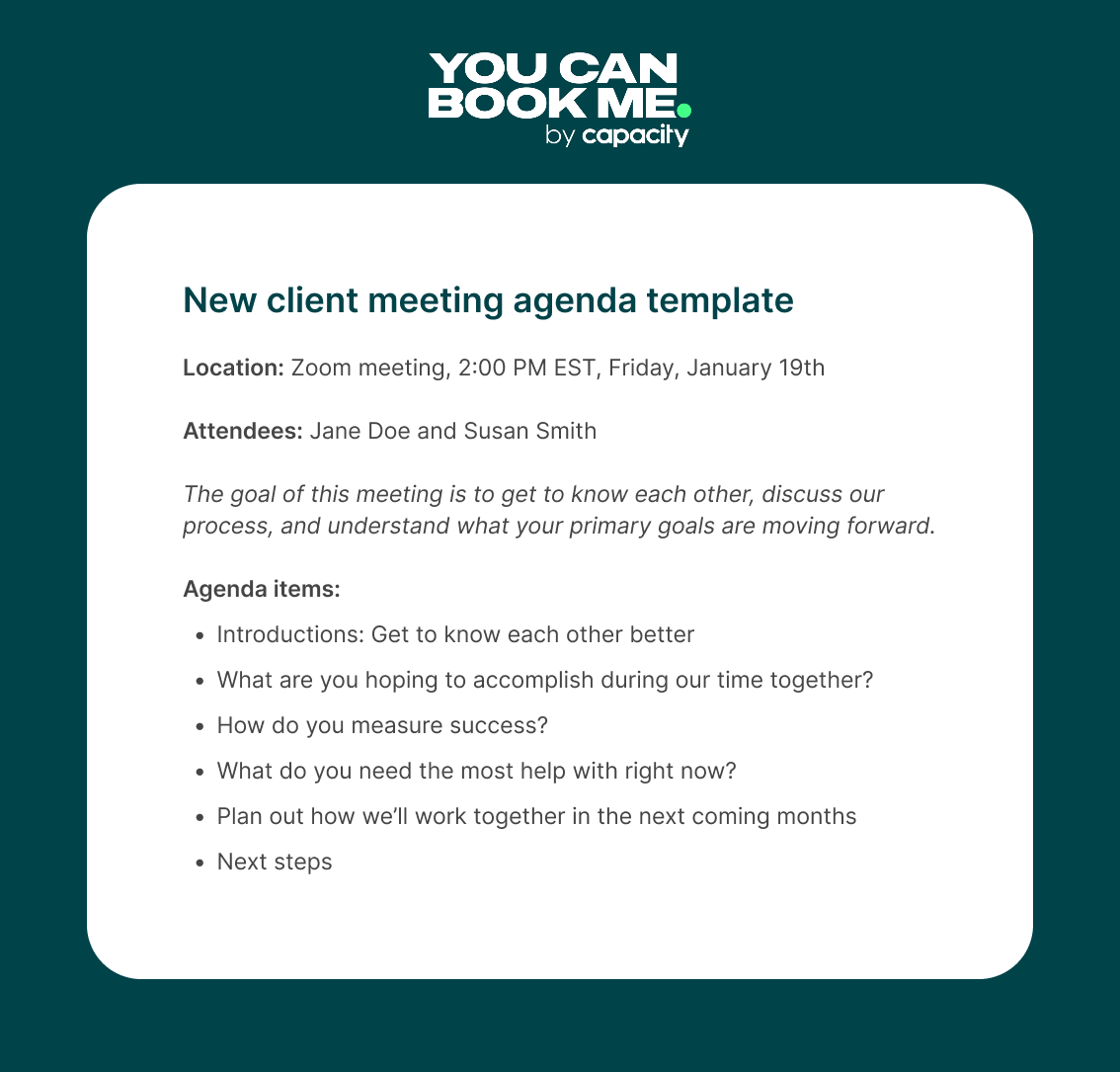
Recurring client check-in meeting agenda
Use this meeting agenda template to stay aligned with your client on ongoing work, track progress, and proactively solve issues:
Google Meet - 10:30 AM PT, Wednesday, August 7
Attendees: Dani and Lee
The objective of this meeting is to review current progress, surface any roadblocks, and align on priorities for the upcoming week.
Agenda items:
-
What were your key wins or accomplishments since our last check-in?
-
Are there any outstanding tasks or blockers we need to address?
-
What’s the current status of in-progress work?
-
How are you feeling about our time together so far?
-
What are your priorities between now and the next meeting? What are mine?
-
Confirm next steps and responsibilities

Discovery or intake meeting agenda
Use this meeting agenda template to gather important context from your prospective client. Ultimately, you'll want to use this time to understand if the prospective client is a good fit for your business, and ultimately qualify your lead, and set the foundation for a successful client relationship should you decide to move forward together:
Zoom meeting, 1:00 PM EST, Monday, October 21
Attendees: Luis and Aisha
The objective of this meeting is to learn more about your business, goals, and challenges so we can tailor our approach to best support you.
Agenda items:
-
Can you tell me more about your business and your role?
-
What are the key challenges you’re facing right now?
-
What goals are you hoping to achieve through this engagement?
-
Who else will be involved in the project?
-
What tools, systems, or workflows are currently in place?
-
What does success look like for you?
- What's your budget for this project?
- What does your timeline look like across start date and length of engagement?

Project kickoff meeting agenda template
Use this project kickoff meeting agenda template when starting a new client engagement to establish goals, expectations, and a strong working relationship:
Zoom meeting, 2:00 PM EST, Thursday, July 11
Attendees: Maya and Jordan
The objective of this project kickoff meeting is to understand your goals, clarify our project scope, and align on next steps so we can start working together efficiently and effectively.
Agenda items:
-
What are your top goals for this project or engagement?
-
What challenges are you currently facing?
-
What does a successful outcome look like to you?
-
Are there any key deadlines or milestones we should be aware of?
-
Who will be the main point of contact, and how would you prefer to communicate?
-
Are there any tools, documents, or systems we should get access to before we begin?
-
What are the next steps following today’s call?
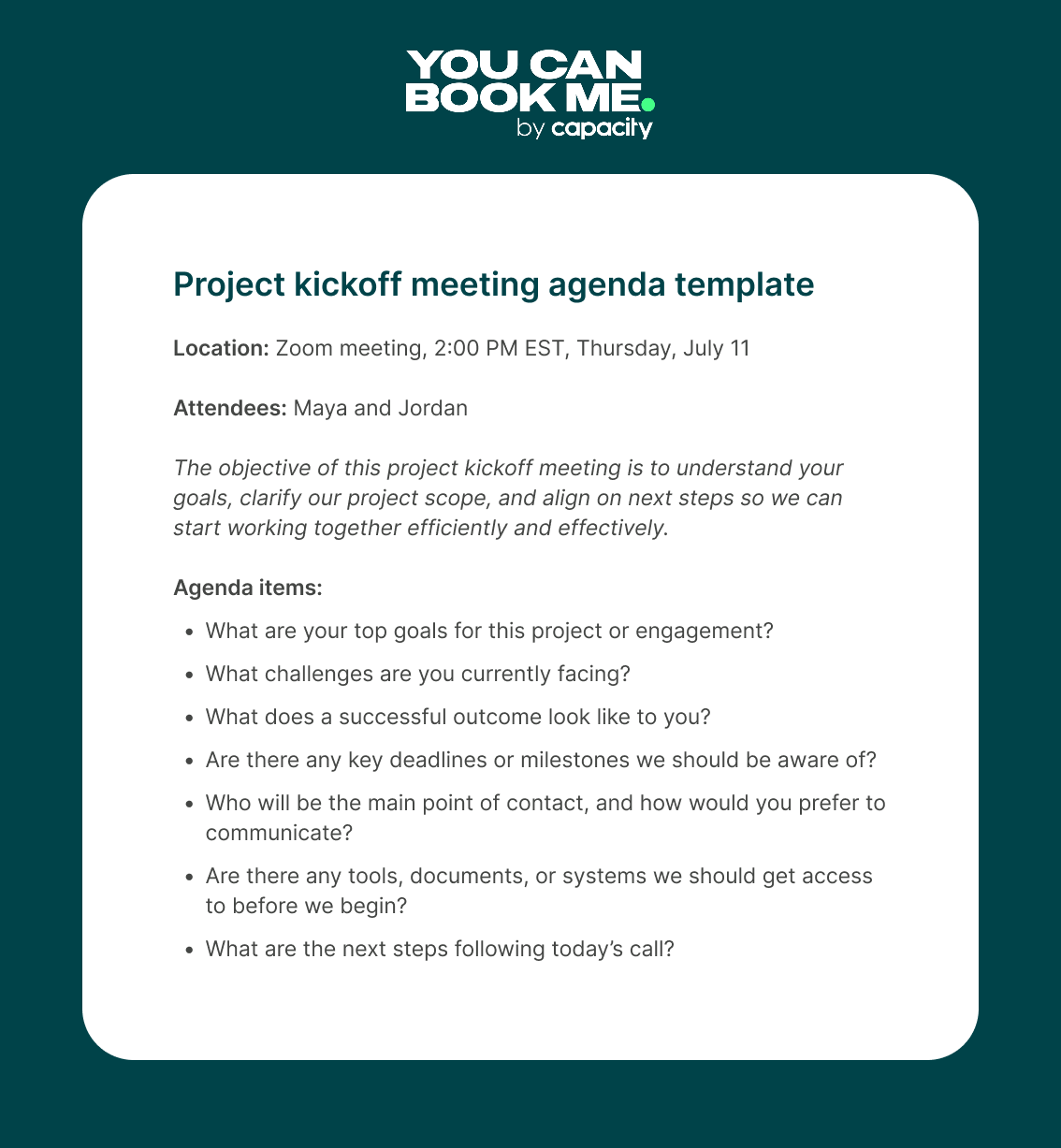
Client meeting agenda for financial coaches
Use this meeting agenda template in your coaching business to work with clients one-on-one or in a group:
Zoom meeting, 11:00 AM PT, Friday, May 16
Attendees: John and Arifa
The objective of this meeting is for me to learn about your financial goals and your current saving and spending habits so I can provide you with a roadmap to reach those goals.
Agenda items:
- What are your long-term financial goals?
- What does financial success mean to you?
- What are your usual monthly saving and spending habits?
- What is your relationship with money?
- What do you want your retirement to look like?

Client meeting agenda for dietitians
Help your client achieve their health and wellness goals by following an agenda like this one.
Zoom meeting, 11:00 AM EST, Monday, December 1st
Attendees: Rajiv Shah and Dianne Gooseberryu
The goal of this meeting is to check in on your health goals, provide education on related nutrition topics, and plan how you’ll achieve your goals next week.
Agenda items:
- Did you meet last week’s goals? If not, what obstacles stood in the way?
- How did you feel after following last week’s meal plan?
- What's a win you had this past week?
- What are some goals we can set together for the coming week?

FAQ about client meeting agendas
What are the benefits of using a client meeting agenda?
Using an agenda for each meeting you run helps you stay organized and respect everyone’s time. You’ll come across as professional and prepared—and you’ll be able to ensure that each meeting is as productive as possible.
What should be included in a meeting agenda?
A meeting agenda should include the details of the meeting, such as its time and place (including links and passcodes) and all required attendees. It should also list the meeting objectives and a list of discussion topics or questions.
What are the four P’s of meetings?
The four P’s involved in a strong meeting are Purpose, Product, People, and Process. By considering each one of these, you’ll know who needs to be involved in a meeting, what you should accomplish, and how you’re going to do it.
How detailed should a client meeting agenda be?
Your client meeting agenda should be detailed enough to give everyone a clear sense of the meeting’s purpose, flow, and expectations—without overwhelming them with too much information. Aim for a high-level overview that includes:
- Meeting logistics (time, date, location or Zoom link)
- The meeting objective (what you're hoping to achieve)
- A list of agenda items or discussion topics
- Any prep work or materials attendees should review beforehand
How do I handle a meeting when we go off-agenda?
It’s completely normal for client conversations to veer off course—especially when new ideas or concerns surface. The key is to gently guide the discussion back on track without shutting down valuable input.
Here’s how to do it gracefully:
-
Acknowledge the detour: “That’s a great point—let’s jot that down and circle back if we have time.”
-
Refocus the group: “To make sure we hit everything we planned, let’s get back to [agenda item].”
-
Take notes for later: Capture off-topic ideas in a shared doc or parking lot so they’re not lost.
-
Leave buffer time: Build in a few extra minutes at the end of your agenda for unexpected discussion.
Flexibility is part of a good meeting—but having a clear agenda gives you the structure to steer things productively.
Subscribe to our newsletter
Get productivity tips, news, articles and resources.
Written by
Hailey Hudson
Hailey is an Atlanta-based, full-time freelance writer who works with clients in the healthcare, marketing, and tech industries. When she's not writing, she's probably belting musical theatre songs or snuggling with her feline WFH supervisor, Windy.


